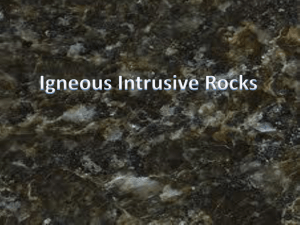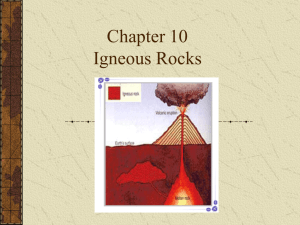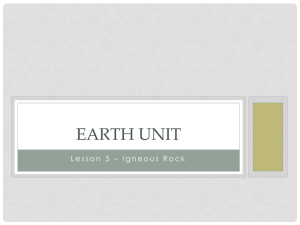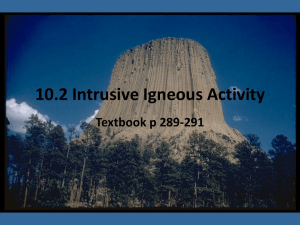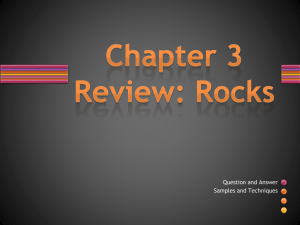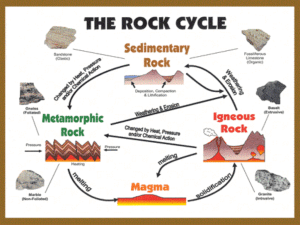rock
advertisement
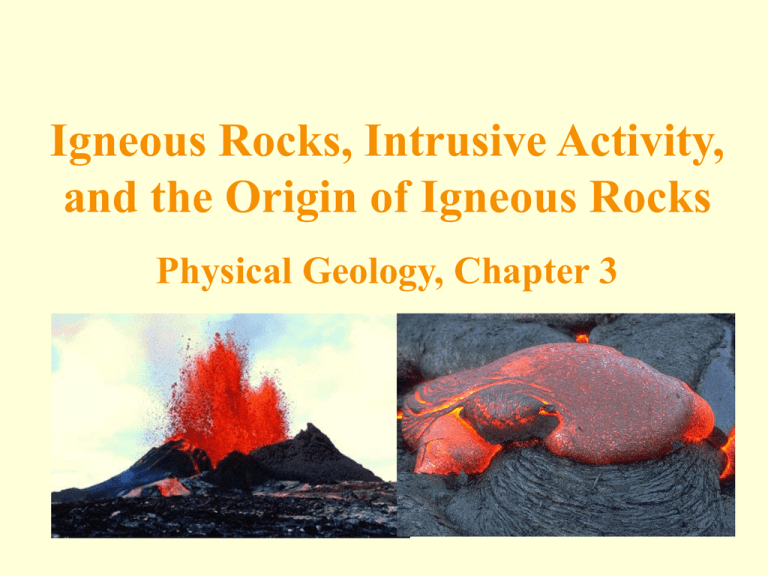
Igneous Rocks, Intrusive Activity, and the Origin of Igneous Rocks Physical Geology, Chapter 3 Quiz 1 Monday Igneous Rocks, Intrusive Activity, and the Origin of Igneous Rocks Physical Geology, Chapter 3 Rocks and the Rock Cycle • A rock is a naturally formed, consolidated material usually composed of grains of one or more minerals. • There are three types of rocks: – Igneous, metamorphic, and sedimentary • Each type has different physical appearance (texture) The Rock Cycle • The rock cycle shows how one type of rocky material gets transformed into another – Representation of how rocks are formed, broken down, and processed in response to changing conditions – Processes may involve interactions of geosphere with hydrosphere, atmosphere and/or biosphere – Arrows indicate possible process paths within the cycle •Types of igneous rocks are closely related to the type of magma and the tectonic environment. •For the most part, volcanic activity is closely linked to interaction between plates (tectonic activity). The Rock Cycle and Plate Tectonics Convergent plate boundary • Magma is created by melting of rock above a subduction zone • Less dense magma rises and crystallizes to form igneous rock The Rock Cycle and Plate Tectonics • Igneous rock exposed at surface gets weathered into sediment • Sediments transported to low areas, buried and harden (undergo lithification) into sedimentary rock The Rock Cycle and Plate Tectonics • Sedimentary rock heated and squeezed at depth to form metamorphic rock • Metamorphic rock may heat up and melt at depth to form magma Igneous Rock Formation • Igneous rocks form when molten rock crystallizes (cools and solidifies) – Molten rock underground • magma – Molten rock on the Earth’s surface • lava Diagram of a Magma Chamber Cooling Basaltic Lava 1. Based on this information, what is one way to classify igneous rocks? Cooling Basaltic Lava on the surface of the Earth Diagram of a Magma Chamber Igneous Rocks Classification • Texture or physical appearance is one way to classify igneous rocks – Texture depends on cooling rate • Slower cooling rates mean that crystals have more time to form and thus will be larger More time Less time Igneous Rocks Classification • Texture or physical appearance is one way to classify igneous rocks – Texture depends on cooling rate • Newton's law of cooling states that the rate of heat loss of a body is proportional to the difference in temperatures between the body and its surroundings One more thing…. 2. Match rock texture, cooling rate, and environment 1. Extrusive A. Fine-grained igneous rock 2. Intrusive B. Coarse-grained igneous rock a. b. “Fast” cooling “Slow cooling Igneous Rocks Formation • Intrusive igneous rocks form when magma solidifies underground • Granite is a common example • Extrusive igneous rocks form when lava solidifies at the Earth’s surface Granite • Basalt is a common example 3. What differences do you see in these two rocks that could have been used for classifying (naming) them? Basalt Igneous Rock Classification • Igneous rock names are based on: – – mineral (chemical) composition texture (grain size) Igneous Rock Chemistry • • Rock chemistry, particularly silica (SiO2) content, determines mineral content and general color of igneous rocks Two general end members: Mafic Felsic Mafic rocks • • • • ~50% silica by weight contain dark-colored minerals that are abundant in magnesium (Ma), iron (Fe), and calcium Gabbro = coarse-grain, intrusive Basalt = fine-grain, extrusive Igneous Rock Chemistry Felsic (silicic) rocks • • • • >65% silica (SiO2) by weight contain light-colored minerals, such as feldspars and silica, abundant in silica, aluminum, sodium, and potassium Granite = coarse-grain, intrusive Rhyolite = fine-grain, extrusive Igneous Rock Chemistry Intermediate rocks have silica contents between those of mafic and felsic rocks • • Diorite = coarse-grain, intrusive Andesite = fine-grain, extrusive Igneous Rock Chemistry Ultramafic rocks • • • < 45% silica by weight composed almost entirely of dark-colored ferromagnesian minerals Most common ultramafic rock is peridotite (intrusive) – Mostly olivine with minor amounts of Ca-rich feldspar and pyroxene Igneous Rock Classification Intrusive SAME chemical composition DIFFERENT cooling rates and environments DIFFERENT rock names! Extrusive Igneous Rock Textures • Texture refers to the physical appearance of the rock – size, shape and arrangement of grains or other constituents within a rock – Fine-grained texture = aphanitic – Coarse-grained texture = phaneritic • Texture of igneous rocks is primarily controlled by cooling rate Aphanitic igneous rock Phaneritic igneous rock Igneous Rock Textures • Extrusive igneous rocks cooled quickly at or near Earth’s surface are typically aphanitic or fine-grained (most crystals <1 mm) • Intrusive igneous rocks cooled slowly deep beneath Earth’s surface are typically phaneritic or coarsegrained (most crystals >1 mm) Fine-grained (aphanitic), extrusive igneous rock …But, what if magma started cooling underground, forming a “mush” of molten rocks, and then erupted? Coarse-grained (phaneritic), intrusive igneous rock Porphyritic Rhyolite Some Other Igneous Textures • Igneous rocks with porphyritic texture have two distinct crystal sizes, indicating that the rock underwent a two-stage cooling process. – Larger crystals (phenocrysts) formed first during slow cooling underground – Smaller crystals (matrix or ground mass) formed during more rapid cooling on or near the Earth’s surface phenocryt Some Other Igneous Textures • A pegmatite is an extremely coarse-grained igneous rock (most crystals >5 cm) formed when magma cools very slowly at depth • A glassy texture contains no crystals at all, and is formed by extremely rapid cooling (quenching) Intrusive Rock Bodies • Intrusive rocks exist in bodies or structures that penetrate or cut through pre-existing country rock Intrusive bodies are given names based on their size, shape and relationship to country rock • – – Deep intrusions: Plutons Shallow intrusions: Dikes, sills, volcanic necks Intrusive Rock Bodies • Intrusive rocks exist in bodies or structures that penetrate or cut through pre-existing country rock Intrusive bodies are given names based on their size, shape and relationship to country rock • – Deep intrusions: Plutons • • • Form at depth beneath Earth’s surface when rising blobs of magma (diapirs) get trapped within the crust Crystallize slowly in warm country rock Generally coarse-grained rocks Deep Intrusive Rock Bodies • Pluton – – Large, blob-shaped intrusive body formed of coarse-grained igneous rock, commonly granitic in composition Small plutons (exposed over <100 km2) are called stocks, large plutons (exposed over >100 km2) are called batholiths Sierra Nevada batholith Intrusive Rock Bodies • Intrusive bodies are given names based on their size, shape and relationship to country rock – Shallow intrusions: Dikes, sills, volcanic necks • • • Form <2 km beneath Earth’s surface Chill and solidify fairly quickly in cool country rock Generally composed of fine-grained rocks Intrusive Rock Bodies • Volcanic neck – • Shallow intrusion formed when magma solidifies in throat of volcano Dike – • Tabular intrusive structure that cuts across any layering in country rock Sill – Tabular intrusive structure that parallels layering in country rock Igneous Rock Identification • Igneous rock names are based on texture (grain size) and mineralogic composition Textural classification • – – • Plutonic rocks (gabbro-diorite-granite) are coarse-grained and cooled slowly at depth Volcanic rocks (basalt-andesite-rhyolite) are typically fine-grained and cooled rapidly at the Earth’s surface Compositional classification – – – Mafic rocks (gabbro-basalt) contain abundant dark-colored ferromagnesian minerals Intermediate rocks (diorite-andesite) contain roughly equal amounts of dark- and light-colored minerals Felsic rocks (granite-rhyolite) contain abundant light-colored minerals How Magma Forms •The Earth is not homogeneous (the same throughout). It has a layered structure, and the layers have different chemical compositions (differentiated). How Magma Forms • • The mantle is solid and is has a basaltic chemical composition high in ferromagnesium silicates Basically, magmas form through melting of the mantle 4. How can a solid become molten? How Magma Forms • Addition of heat – – Heat transferred upward (by conduction and convection) from the very hot (>5000°C) core through the mantle and crust Rate at which temperature increases with increasing depth beneath the surface is the geothermal gradient • Gradient is not the same everywhere How Magma Forms • Decrease pressure – – Melting point of minerals generally increases with increasing pressure Decompression melting can occur when hot mantle rock moves upward and pressure is reduced enough to drop melting point to the temperature of the rising rock body How Magma Forms • Add water or other contaminant – Hot water under pressure • • – Water becomes increasingly reactive at higher temperatures At sufficient pressures and temperatures, highly reactive water vapor can reduce the melting point of rocks by over 200°C Mineral mixtures • Mixtures of minerals, such as quartz and potassium feldspar, can result in the melting of both at temperatures hundreds of degrees lower than either mineral would melt on its own How Magma Forms • The mantle is solid and is has a basaltic chemical composition • Basically, magmas form from melting of the mantle • Mantle melts due to: – Increased heat – Decreased pressure – Addition of water Magma Crystallization and Melting Sequence • Minerals crystallize in a predictable order (and melt in the reverse order), over a large temperature range, as described by Bowen’s Reaction Series Magma Crystallization and Melting Sequence8 • Bowen’s Reaction Series has two branches. – Discontinuous branch • • – Ferromagnesian minerals (olivine, pyroxene, amphibole, biotite) crystallize in sequence with decreasing temperature As one mineral becomes chemically unstable in the remaining magma, another begins to form Continuous branch • Plagioclase feldspar forms with a chemical composition that evolves (from Ca-rich to Na-rich) with decreasing temperature – Often forms zoned crystals Bowen’s Reaction Series Lessons from Bowen’s Reaction Series • Large variety of igneous rocks is produced by large variety of magma compositions Mafic magmas will crystallize into basalt or gabbro if early-formed minerals are not removed from the magma Intermediate magmas will similarly crystallize into diorite or andesite if minerals are not removed Separation of early-formed ferromagnesian minerals from a magma body increases the silica content of the remaining magma • • • – – • Differentiation or fractional crystallization Can produce granites from basaltic magma Minerals melt in the reverse order of that in which they crystallize from a magma Magma Evolution • • A change in the composition of a magma body is known as magma evolution Magma evolution can occur by: – – – – differentiation, partial melting, assimilation, or magma mixing Magma Evolution • • Differentiation or fractional crystallization involves the changing of magma composition by the settling of denser early-formed ferromagnesian minerals The removal of some components means that the relative % of the other components remaining in the magma increases (enriched) Magma Evolution • Incomplete or partial melting produces magmas less mafic than their source rocks\ – – Minerals melt in the reverse order of that in which they crystallize from a magma Lower melting point minerals are more felsic in composition Magma Evolution • Assimilation occurs when a hot magma melts and incorporates more felsic surrounding country rock Magma Evolution • Magma mixing involves the mixing of more and less mafic magmas to produce one of intermediate composition Putting it all together: Igneous Activity and Plate Tectonics • Igneous activity occurs primarily at or near tectonic plate boundaries • Mafic igneous rocks are commonly formed at divergent boundaries – Increased heat flow and decreased overburden pressure (decompression melting) produce mafic (basaltic) magmas from melting of the mantle Igneous Activity and Plate Tectonics • Intermediate igneous rocks are commonly formed at convergent boundaries – Partial melting of basaltic oceanic crust due to the addition of water produces intermediate magmas Igneous Activity and Plate Tectonics • Felsic igneous rocks are commonly formed adjacent to subduction zones (convergent boundary) – – Water from subducting crust lowers melting point Resulting hot rising magma causes partial melting and assimilation of the granitic continental crust Igneous Activity and Plate Tectonics • Intraplate volcanism – Rising mantle plumes can produce localized hotspots and volcanoes when they produce magmas that rise through oceanic or continental crust • • Hawaii is an example of intraplate volcanism in oceanic crust Yellowstone is an example of intraplate volcanism in continental crust Magma, Rock Types, and Plate Tectonic Setting Rock Starting Ending Melting Processes Magma Magma Basalt Gabbro Mafic Andesite Diorite Mafic (usually) Rhyolite Granite Felsic (silicic) Mafic Intermediate Tectonic Setting Mantle melting due to decreased pressure or increased heat Divergent Hot spot (intraplate) Partial melting of mantle through addition of water Subduction zones (assimilation, differentiation, or magma mixing) Felsic Partial melting of lower crust Convergent boundaries Hot spot End of Chapter 3… …Wednesday, Chapter 4 Volcanism and Extrusive Igneous rocks

